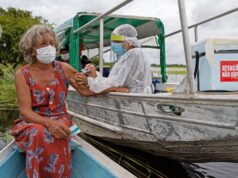The microorganisms lifted off from Cape Canaveral, Florida, on 25 July 2019, headed for the International Space Station, some 400 kilometres above. Their mission: to boldly mine basalt, in low Earth orbit, where no living organisms had mined before.
Five days after take off, astronaut Luca Parmitano unpacked microbe-laden cartridges and installed them in an incubator. The bacteria were given liquid growth media plus Icelandic basalt, from which, Earth-based experimenters hoped, they would extract valuable rare-earth elements1.
When Parmitano, a European Space Agency astronaut based in Houston, Texas, thinks about microbes, he mainly worries about how they might harm him, and how to prevent them from contaminating lifeless environments such as the Moon. But as space agencies look beyond the space station’s low Earth orbit, scientists say that microbes are poised to take on new and beneficial roles, including mining useful elements, making foodstuffs and medicines, and creating the building blocks for habitats.
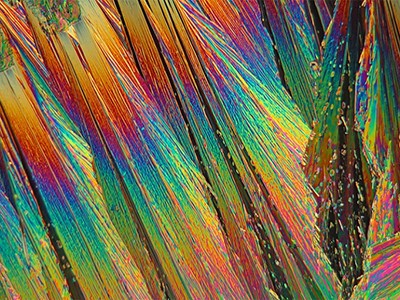
Microbial miners take on rare-earth metals
“Microorganisms can do a lot of different tasks for us,” says space microbiologist Rosa Santomartino, co-director of the UK Centre for Astrobiology at the University of Edinburgh and co-organizer of the study that sent the microbes up in 2019. “Particularly, microorganisms are going to be important in the long-term and long-distance space experiments,” she adds.
That’s because the farther spacefarers travel, the harder and more expensive it will become to ship all the supplies that they’ll need. The International Space Station will close down in 2030, but the space station Lunar Gateway, which will orbit the Moon, will open in 2028 or so; Mars, and perhaps asteroids, are also on the horizon. Planners are therefore looking for ways to make what they need from what’s already available at their destination, and to recycle waste.
Microbes, which have evolved on Earth to perform all manner of chemical transformations, could be big assets in such work. But much is still unknown about how microbes will react to conditions in space, and even basic experiments can be tough to carry out.
“We just have so much to do to understand what microbes are going to do up there, what they’re not going to do up there, and how can we make them do what we want them to do?” says Cheryl Nickerson, a microbiologist at Arizona State University in Tempe.
Multifunctional microbes
Researchers predict myriad mission tasks for space-bound microbes, including producing breathable oxygen, purifying water for drinking and supplying nutrients to crop plants. At NASA’s Ames Research Center in Moffett Field, California, synthetic biologist Lynn Rothschild works with the soil bacterium Bacillus subtilis. A hardy microbe capable of forming long-lasting spores, B. subtilis has already proved it can survive the extremes of space travel. Rothschild hopes to engineer it to remediate toxic compounds called perchlorates that are naturally present in Martian water sources and to produce medicines.
Astronauts might require any number of medications during a Mars mission, which could take nearly three years including 18 months in transit and time on the planet’s surface working and waiting for the planets to align for the return journey. Drugs that would counter damage to their bones from solar radiation, for instance, could come in handy. “You can’t take an entire pharmacy,” Rothschild says. “And even if you could, they go bad.” She and others hope to engineer bacteria to produce any medicines needed, to order and en route.
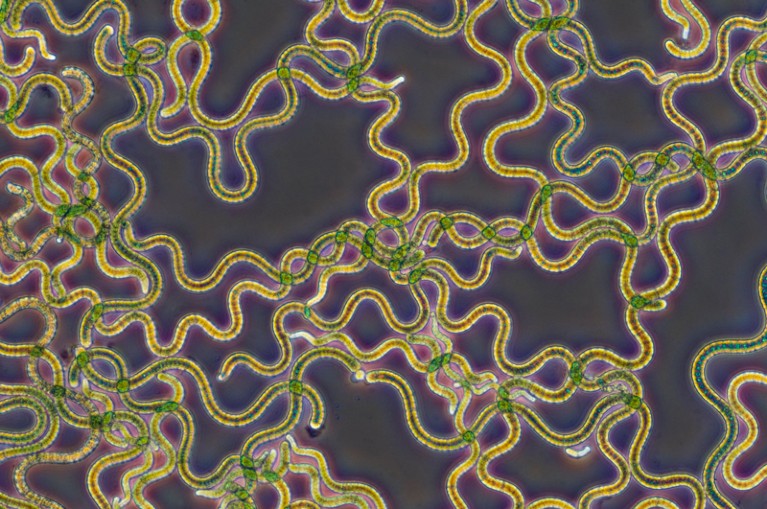
Spirulina cyanobacteria have been engineered to produce painkillers.Credit: Sinclair Stammers/Science Photo Library
While Rothschild predicts a library of dried-up B. subtilis spores, ready to re-animate and pump out medication, scientists at the University of California, Berkeley, are considering another group of microbes, called cyanobacteria. These organisms are photosynthetic, so they would use sunlight and the carbon dioxide already present in the Martian atmosphere. As a bonus, photosynthesis produces something else astronauts will need — oxygen.
Berkeley bioengineer Adam Arkin and his colleagues have engineered the cyanobacterium Arthrospira platensis, commonly known as spirulina, to synthesize the painkiller paracetamol (acetaminophen)2. It takes just two added genes, one from a bacterium and one from a mushroom, to get spirulina to convert the amino acid tyrosine into the drug. Arkin speculates that if they could get the microbes to make enough of it, astronauts could skip chemical purification and ingest the microbes directly — in a smoothie, he suggests — to quell a headache. But, he admits, there’s one significant gastronomic hurdle: “You’d be eating a lot of spirulina. And I promise you, nobody wants to eat a lot of spirulina. It tastes like armpits.”
Lunar cement
Microbes can also produce building materials, and even habitats. For housing, Rothschild is pursuing fungi, or what her team calls myco-architecture3. Fungi could transform feedstocks, such as wood chips or perhaps some sort of nutritious hydrogel, into long strands called hyphae. Such a material would have many advantages, including blocking radiation and sound and being relatively fire resistant. Rothschild says it even looks ‘cosy’, like chipboard — more home-like than, say, steel walls. She and her colleagues imagine sending up inflatable habitat moulds that are pre-seeded with fungi and their food; just add water and oxygen, and the fungi should do the rest.
At the Indian Institute of Science in Bangalore, mechanical engineer Aloke Kumar is thinking about a more conventional building material: bricks. Regolith, the loose rock and dust that tops the bedrock of Mars and the Moon, is more sand than clay — no clay at all on the Moon — so it needs help to stick together. Kumar proposes the assistance of Sporosarcina pasteurii. Found in sewage and soils, S. pasteurii convert soil urea into carbonate ions. Engineers on Earth have used the organism to remediate soils, and to produce limestone for biocement by combining the carbonate with calcium ions.
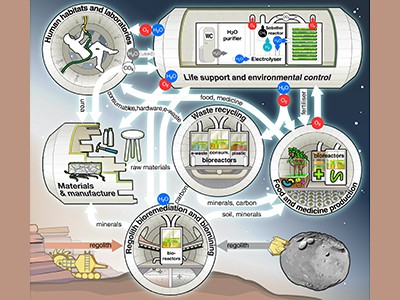
Toward sustainable space exploration: a roadmap for harnessing the power of microorganisms
Kumar’s team tried mixing the microbes and a calcium salt with simulated versions of lunar or Martian regolith4, which are available from government space agencies and commercial suppliers. After five days, the microbes had made bricks, although not particularly good ones. “I could crush these bricks with my own hands,” says Kumar.
Perhaps, he mused, a natural additive would help. The team landed on guar gum, a binding and thickening agent used in applications such as textiles and cosmetics. Adding 1% guar gum resulted in tougher ‘space bricks’ as the team calls them; Kumar thinks that it makes the sandy regolith more habitable for the microbes, and that they probably eat it.
Beyond structural applications, Santomartino and her colleagues hope to mine regolith, too. Microbes are already used on Earth to leach metals such as copper and gold from ore, and researchers are assessing their potential to collect the rare-earth metals that are essential for modern technologies such as mobile phones and wind turbines. A key question in their 2019 International Space Station experiment, known as BioRock, was whether microgravity would influence the ability of the soil microbe Sphingomonas desiccabilis to leach rare-earth elements and vanadium out of the rock. They compared the low-gravity space station cultures to controls on Earth. Parmitano also used centrifuges to simulate Earth gravity and Mars gravity, which is about three-eighths that of Earth.
Over three weeks in culture, the microbes extracted small amounts of rare-earth elements from the rock — enough to prove the principle. But to the researchers’ surprise, gravity was largely irrelevant to S. desiccabilis1. They’d anticipated that in microgravity, there would be less mixing of the microbes with their media, leaving the bacteria undernourished, but the microbes’ needs seem to have been met. However, the researchers caution that they used just five millilitres of culture; the situation might be different if the experiment were scaled up.
Microbes could even produce the raw materials for making tools. Benjamin Lehner, director of the Dutch Marine Energy Centre in the Hague, the Netherlands, used microbes to extract iron from simulated regolith during his doctoral studies at Delft University of Technology in the Netherlands. His workhorse was Shewanella oneidensis, a soil- and deep-sea-dwelling microbe with no need for oxygen and a natural ability to reduce metal ions to create pure metal. Once the microbes processed the iron in the regolith, Lehner collected the metal using magnets. He then fed it into a 3D printer to produce cylinders, which were four times stronger than versions made without microbial help5, he says — probably because the microbe-mined material contained higher amounts of iron and lower levels of silicon.
A lot to learn
Arkin and other astro-microbial engineers propose linking bioreactors to create ‘closed loop’ systems, in which the waste of one bioreactor feeds into the next, to grow food, produce breathable air and perform other tasks in an all-in-one solution.
But first, scientists have a lot to learn about microbial growth and activity beyond Earth. Although the International Space Station is slated to be de-commissioned, commercial companies such as Voyager Space, Airbus and Axiom Space will offer opportunities in low Earth orbit, the satellite-filled region about 160–1,600 kilometres above Earth’s surface. Even that close to home, researchers face many challenges. “Doing microbiology in space is 100% nothing like what you’ve done in your lab,” says Nickerson. “It’s not even close.”
The main challenge in low Earth orbit is the lack of gravity, so researchers typically pair their space experiments with Earth-based controls. Microgravity can affect microbes in unexpected ways. For example, in Nickerson’s early experiments, Salmonella typhimurium that had been to the space station made mice sicker than did cultures that stayed on Earth6. Microbes probably don’t sense the lack of gravity itself, Nickerson says, but they do experience less mixing in the liquid media. Nickerson has found that the fluid force surrounding space-faring microbes seems to mimic conditions inside animal intestines, in which Salmonella species would naturally activate their infectious abilities.
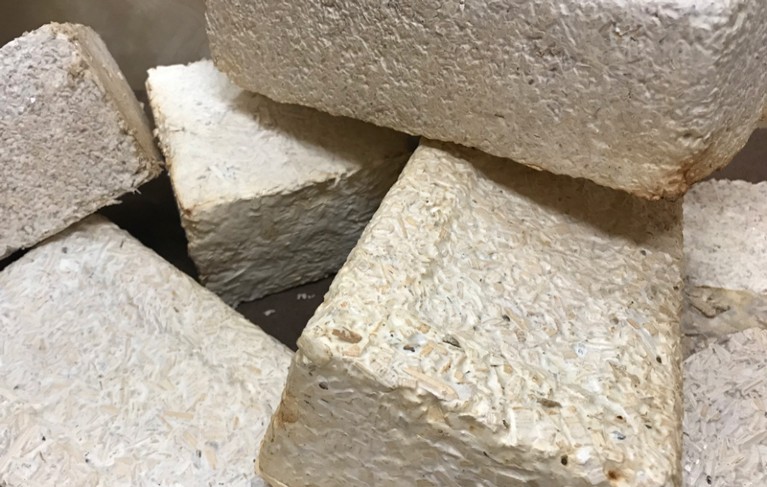
Bricks produced using mycelium, garden waste and wood chips as a part of a myco-architecture project.Credit: NASA
The launch itself is also a huge stressor, notes Nicol Caplin, a deep-space exploration scientist at the European Space Research and Technology Centre in Noordwijk, the Netherlands. She recommends shipping cultures desiccated and in stasis so that they won’t react to the launch; alternatively, scientists can use centrifuges or vibration plates to mimic the launch effects on terrestrial controls.





